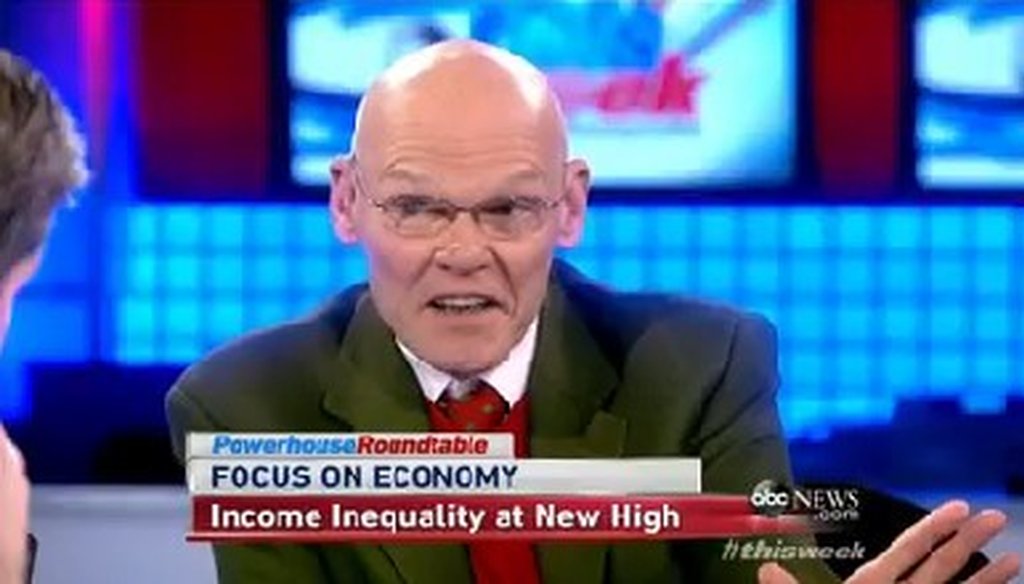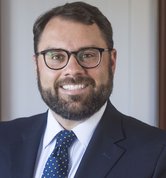Stand up for the facts!
Our only agenda is to publish the truth so you can be an informed participant in democracy.
We need your help.
I would like to contribute

Democratic pundit James Carville appeared on the Sunday, Dec. 8, 2013, episode of ABC's "This Week."
Fox analyst Brit Hume said Sunday that President Barack Obama’s decision to start talking about raising the minimum wage and income inequality was a political calculation to shift discussion away from the health care law.
If so, it worked.
Sandwiched between tributes to former South African president Nelson Mandela, the Sunday news shows devoted significant time debating whether to raise the federal minimum wage, which has stood at $7.25 an hour since 2009.
Democrats generally support raising the minimum wage while Republicans worry that doing so could force employers to cut jobs.
On ABC’s This Week, Ohio Sen. Rob Portman explained the concerns of Republicans by offering a flurry of statistics.
Sign up for PolitiFact texts
"If you want to deal with income inequality, the No. 1 way to do it is to get people to work. That's what all the statistics show. About 2 percent of Americans get paid the minimum wage," Portman said. "Of that group, by the way, less than .3 of 1 percent of Americans are both under poverty -- under the line of poverty -- and on minimum wage. So it's a lot of young people. About 50 percent of them are between 16 and 24 years old. For a lot of them, it's a part-time job. So what you don't want to do is raise the minimum wage to the point that you're actually losing jobs."
We decided to fact-check Portman’s claim that "about 2 percent of Americans get paid the minimum wage."
Portman has it about right. According to the federal Bureau of Labor Statistics, a little under 3.6 million workers were paid either at or below the federal minimum wage in 2012. That’s roughly 2.6 percent of all workers.
Where Portman erred slightly is by saying "Americans" and not workers, since not all Americans can or do work. Also, federal officials say the number of workers making the minimum wage is somewhat understated because it only includes hourly employees. We rated Portman’s claim Mostly True.
Later on This Week, host George Stephanopoulos continued the conversation with a roundtable of pundits -- including the dueling husband-and-wife team of liberal James Carville and conservative Mary Matalin.
Offered Carville: "Can I just make one jaw-dropping point? This week it came out, a UC Berkeley study said …one-third of all bank tellers (are) on public assistance. This is bank tellers. These are people that have a level of skill."
Carville went on to say Congress should pass a law that mandates private-sector companies offer a living wage to their employees if they are part of a government bailout or profitable.
As Carville said, that statistic comes from a study by the University of California-Berkeley Center for Labor Research and Education. A New York City group, the Committee for Better Banks, commissioned the analysis. The committee says it represents the interests of frontline and back office bank workers.
"Salaries for bank tellers nationwide are so low that 31 percent of bank tellers and their family members are enrolled in some type of public assistance program," the committee cites in its report.
That public assistance takes many forms. The grand total is nearly $900 million, with Medicaid and the Children’s Health Insurance Program accounting for over half. Food stamps, the Earned Income Tax Credit and welfare (Temporary Assistance for Needy Families) make up the remainder.
Carville made a minor error in talking about the bank tellers themselves when the study included their children. And there is debate among experts as to whether children’s insurance and the Earned Income Tax Credit, which were included in the study, should be counted as public assistance. We rated his claim Mostly True.
Our Sources
See individual fact-checks.






















